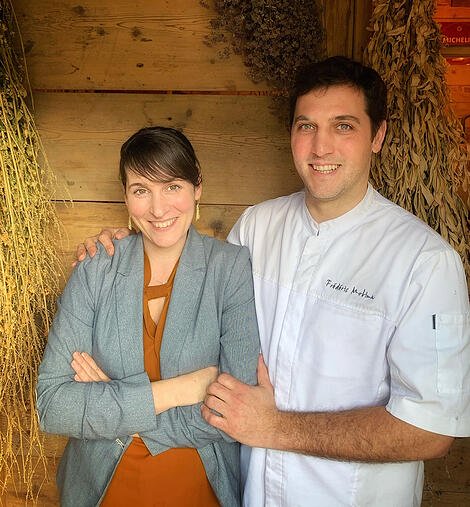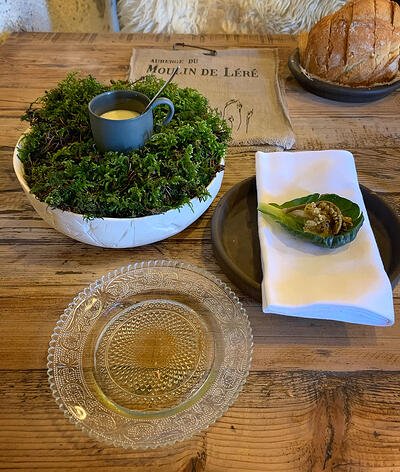Who said that setting up shop in a central, fancy location with state of the art decor was the way to secure a Michelin star? These three examples showcase the fact everything is possible, award-wise, if your produce is top quality, carefully-sourced, imaginatively put together and consistently delicious.
Hong Kong Soya Sauce Chicken Rice & Noodle stall – Singapore
In 2016, Malaysian chef Chan Hon Meng, (also known as ‘Hawker Chan’), won the first ever Michelin star awarded to a street food stall. His intimate Chinatown hawker joint, abbreviated to a rather complicated HKSSCRN, is one of 108 hawker centers located in the downtown Singapore, where street food plays such a significant role in people’s lives that it even gets referenced in popular culture, (see the film/book ‘Crazy Rich Asians’).
The stall itself is fairly unremarkable by Singaporean standards, with its basic lit-up signage and row of cooked chicken hanging from hooks, it could be any other chicken stall in hawker centres across the country. But the price makes it the most affordable Michelin-starred meal you can get, a plate of the famous soya sauce chicken and rice costs just under S$2.
«It is certainly a test of endurance, for both patrons and workers. There’s no air-conditioning, and the steam from all the surrounding stalls adds to the muggy, tropical climate. Diners jostle in the narrow aisles between tables, balancing plates and bowls of hot food on plastic trays. Elderly cleaners navigate their trolleys around the bustle, shouting for people to make way.» (1)
Meng’s typical 17-hour day produces the finest Hong Kong-style soya sauce chicken that has hungry customers queuing around the block for 2/3 hours. He starts washing the chickens at 7am and by 2pm, lunchtime customers are turned away because stocks are depleted, patrons must return for the evening session. It’s a strict 180 chickens per sitting, that’s already 30 more than before he won the award.
The 52-year old chef was born in rural Malaysia to farmer parents who often included him in working the land and animals. Leaving school at 15, he went to find work in the restaurant trade in Hong Kong where he learnt, and later perfected, the sticky stewing broth recipe that has made him so famous. Despite the humble setting of his hawker stall, Meng makes it his life’s work to guarantee all chickens are cooked to perfection, succulently soft and tender every time.
“Meng proves elusive, inadvertently hiding between bars of golden brown chickens and red pork drying on hooks.He sieves noodles, adds sauce, tosses noodles to water, pivots, douses noodles, adds meat, plates it and then begins the next masterpiece. It’s like Gustav Klimt painting The Kiss over and over again, eager clients gawking at every flourish. Chicken glistens at HKSSCRN. The meat is slick, not greasy. Bouncy yet delicate. Salty soy animates the crispy-lined pork edges and chicken skin.” (2)
Upon winning the award, the incredulous Meng was told by his Michelin representative, “We judge based on the food, not on the venue”.These words were music to Meng’s ears, since putting Singapore street food on the international gastronomic map had always been an ambition of his. He now shares the accolade with another Singapore stall, Hill Street Tai Hwa Pork Noodle, that turns out consistently perfect minced meat & noodles (‘bak chor mee’) and boasts similar queues around the block.
A total of 33 hawker stalls received ‘Bib Gourmand’ awards for the Michelin Guide Singapore 2019. Interesting to note that it’s in one of the most expensive cities in the world that you can find the cheapest Michelin starred meals. Our man Meng has since opened four more sites in Singapore, as well as chain outlets in Malaysia, Taiwan and Australia, with the intention of making his soya sauce chicken chain as big as KFC.
Le Berceau des Sens, EHL training restaurant – Lausanne
Nestled in a corner of the prestigious Ecole hôtelière de Lausanne on the outskirts of the city, Le Berceau des Sens (‘The Cradle of the Senses’) is today the only training restaurant in the world to earn a Michelin Star for two consecutive years. This unique in-house training cuisine had already won16 out of 20 points from the French restaurant guide, Gault & Millau in 2017 - another sought-after award very much due to the efforts of Head Chef Cédric Bourassin and his first-class team.
Heading the BDS kitchen since September 2017, Cédric Bourassin offers a menu inspired by exceptional French cuisine, influenced by his previous work with Anne-Sophie Pic and the Bras family in Laguiole. But the menu is also in pursuit of ‘umami’, the fifth flavor that the passionate chef was able to explore during his long stay in Japan,where after 16 years he achieved his ultimate career goal by obtaining a 3-star Michelin rating for the Michel Bras TOYA restaurant in Toyako-co as Head Chef and Director.
CB: “No dish leaves the kitchen without being checked by me or one of my sous-chefs – not just for its correct assembly, but also to decide the order in which the dishes are served. In Japan I worked in a restaurant that had three Michelin stars and no detail was ever overlooked.”
 Chef Cédric Bourassin
Chef Cédric Bourassin
The fact that BDS is the training ground for many EHL students resulting in constant flux as trainees switch duties daily, poses the question as to how Bourassin manages to keep the key element of consistency stable and uninterrupted throughout the academic year. The team of trainee students changes every Monday and each learner has to rotate between five different posts: meat, fish, patisserie, cold and hot food, experiencing work both in the kitchen and at the tables. The BDS website charmingly warns clients to expect to be served by trainee students “without experience and sometimes with a touch of shyness”.
CB: “It’s important to empower those around me, including the trainees. I go out of my way to establish a perfect understanding between myself, my sous-chefs, chefs de partie and the students. We have a briefing session every morning that covers all issues from the previous day.”
The Michelin assessment criteria bases itself on quality products, mastery of flavor and cooking techniques, chef’s personality and creativity, value for money, and most importantly, consistency. The inspectors agreed that these ingredients have all been been maintained, if not exceeded by BDS, since the star was awarded a year ago. Bourassin is keen to emphasis a fundamental point that in his opinion is why his Michelin star has been preciously kept.

CB: “I’m not a magician who can make an outstanding dish out of poor ingredients! The use of quality products has always been the most important starting point for me. I know this is one of the main reasons why BDS gained its first star a year ago. Sourcing fresh, local, sustainable produce has always been a priority of mine. We use as much locally-sourced ingredients as possible, for example fish from our lake, beef from Bern, cardoons from Geneva, kiwis from Morges, our salads and herbs are all locals and when possible grown in the EHL garden.”
The added criteria of sustainability has gathered momentum over the past few years and is an area which Bourassin is innately committed to. He refuses to touch Sea Bass during the months of February and March, despite being cheap and easily available, because the fish is in full reproduction and the eggs must be left to ensure future stocks. He advocates sticking to the local Swiss Fera instead.
BDS is considered an unusual fine dining experience for its remote suburban location and trainee set-up. What is also unusual are the reasonable prices for such high quality standards and creative culinary ideas. References to the excellent wines, cheeses and desserts are constant features on the online review platforms, as is the need to book months in advance for a table. The restaurant is indeed a bijou in the crown of the region’s eating experiences.
Moulin de Léré – Vailly, France
“Location, location, location…! “ Maybe not the first consideration that went through the minds of Chef Frédéric Molina and his partner Irene when they took over a former auberge in Haute-Savoie. Vailly feels like a village in a lost valley tucked behind the hills above Thonons les Bain, just over an hour from Geneva. The striking building, a fully working mill, instantly caught the imagination of the young couple when in 2014 they decided to take a leap of faith and craft their own unique fine-dining restaurant. Toughing it out through the early years and keeping things local, in more senses than one, they were surprised and delighted to receive a Michelin Star in January 2019. Being truly in the middle of nowhere seemed to play to their advantage.
 Chef Frédéric Molina, and his partner Irene
Chef Frédéric Molina, and his partner Irene
Frédéric, who grew up on a family farm in the south-west of France, learnt the importance of local produce from an early age. He honed his cooking skills working for more than 15 years across Europe, Asia and Australia. In creating the Moulin de Léré, Frédéric was able to put into place a principled and responsible form of inspired cuisine. Here there is a constant learning focused on local ingredients and the forming of genuine relationships with regional suppliers. He talks about the essential synergy that comes from strong bonds with local producers, being able to discuss and choose the right products as they mature or come into season.
FM: “You can have a great learning experience wherever you work and whatever the level of the venue. I’ve worked in pubs, pizzerias, traditional bistros and Michelin Star restaurants, they have all helped shape my philosophy towards my cuisine.”
Frédéric and Irene describe life before and after they were awarded their star. They joke about how they never expected to receive one and how difficult it was beforehand to get a journalist to write about their restaurant’s locally-focused ambitions. Since the star arrived, the phone hasn’t stopped ringing from curious guests and journalists alike. Months that were previously quiet are now busy and guests are well-advised to book in advance. They are greatly appreciative of the local support that carried them through the early years. Now, the customers come from far and wide but they still cherish and cultivate their bonds with their loyal local clientele.
The kitchen and service teams hum with a joyful continuity that is backed up by a family-feel atmosphere. Frédéric mentions that the staff were all formerly customers before they joined the restaurant. They saw something special in what the Moulin de Léré was trying to achieve and wanted to be a part of that journey. Frédéric’s sous-chef left a two-star Michelin restaurant to join this brigade. Apprentices who came from local hospitality schools have since become full-time employees. This young and vibrant team all live nearby and enjoy the empowerment and learning that comes through a restaurant that genuinely cares for what it offers.

The menu is focused on hyper-seasonality and this means the kitchen team are constantly engaged in the foraging and gathering of ingredients and presentational flora, some of which may only be in season for a matter of days. Frédéric and Irene have been smart in empowering their young team, who are naturally tuned into the use of Instagram and Facebook, to promote this playful seasonality on their social media channels. This has served to increase customer engagement and curiosity.
FM: “Our kitchen team are out foraging at least three times a week and the restaurant is only open five days a week. Our knowledge of what grows where, in the mountains, in the forest or beside the lake, is expanding all the time. Quite often my chefs will be gathering naturally-found produce on their days off! Once you have that passion it never stops. It always pleases me to get a photo from one of my team declaring – ‘Hey look what I’ve just found!’ ”
The Moulin de Léré is truly deserving of its Michelin Star. When the team started out, they didn’t exactly know what they were going to do but they absolutely knew what they didn’t want to do. It is their principled approach to responsible cooking with a high environmental regard which has been the catalyst to their success. They both see the awarding of a star as fresh impetus for them and their loyal team to continue doing what they do best: Championing local produce, producers and continuously developing their knowledge of what lies on their remote doorstep.
----------------------------------------------------------------------------
References
- Michelin star for Singapore noodle stall where lunch is half the price of a Big Mac.
- Where to find the world’s cheapest Michelin-star food
Senior Lecturer of Business Communication at EHL





